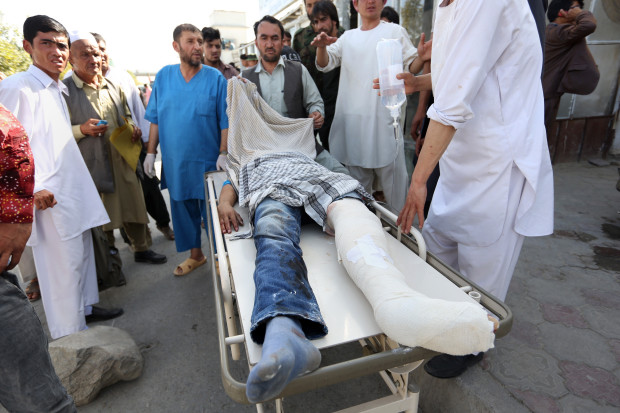Witnesses: Deadly blast strikes demonstration in Kabul

Afghans help an injured man after an explosion struck a protest in Kabul, Afghanistan, on July 23. AP
KABUL, Afghanistan—An explosion struck a large demonstration march in the Afghan capital, Kabul, on Saturday, causing multiple casualties, according to officials and witnesses.
The marchers were ethnic Hazaras demanding that a major regional electric power line be routed through their impoverished home province. Most Hazaras are Shiite Muslims but most Afghans are Sunni.
Sediq Sediqqi, spokesman for the Ministry of Interior, said police were working to confirm how many blasts had taken place and how many people were killed and injured.
“We can’t yet identify what sort of blast it was or how many people have been affected,” he said. “We are right now in a very difficult situation.”
Eyewitness Ramin Anwari described seeing up to eight bodies in the Demazang area, where protesters were preparing to set up a camp after a four-hour march. He had no further details.
Article continues after this advertisementOne of the march organizers Laila Mohammadi said she arrived at the scene soon after the blast and saw “many dead and wounded people.”
Article continues after this advertisementFootage on Afghan television and photographs posted on social media showed a scene of carnage, with numerous bodies and body parts spread across the square.
Angry demonstrations sealed some of the area around the square, and prevented police and other security forces from entering. Some threw stones at security forces.
President Ashraf Ghani released a statement condemning the blast. “Peaceful demonstrations are the right of every citizen of Afghanistan and the government will do everything it can to provide them with security,” Ghani said.
His spokesman, Haroon Chakhansuri said Ghani would appear on live television later in the day.
Amnesty International issue a statement saying the “horrific attack” on the Hazara demonstration “demonstrates the utter disregard that armed groups have for human life.”
“Such attacks are a reminder that the conflict in Afghanistan is not winding down, as some believe, but escalating, with consequences for the human rights situation in the country that should alarm us all,” it quoted Champa Patel, Amnesty’s South Asia director, as saying.
No group has yet claimed responsibility for the blast. The Taliban have been waging a vicious insurgency against the Kabul government for 15 years, since their regime was overthrown by the U.S. invasion in 2001.
Violence had been feared at what was the second demonstration by Hazaras over the power line issue. The last one in May attracted tens of thousands of people, also shutting down the central business district.
The May march was attended by Hazara political leaders, who were notable by their absence on Saturday.
At the height of the march, demonstrators chanted slogans against President Ashraf Ghani and Chief Executive Abdullah Abdullah, shouted “death to discrimination” and “all Afghans are equal.”
The so-called TUTAP line is backed by the Asian Development Bank with involvement of Turkmenistan, Uzbekistan, Tajikistan, Afghanistan and Pakistan. The original plan routed the line through Bamiyan province, in the central highlands, where most of the country’s Hazaras live.
That route was changed in 2013 by the previous Afghan government. Leaders of the marches have said that the rerouting was evidence of bias against the Hazara community, which accounts for up to 15 percent of Afghanistan’s estimated 30 million-strong population.
They are considered the poorest of the country’s ethnic groups, and often complain of discrimination. Bamiyan is poverty stricken, though it is largely peaceful and has potential as a tourist destination.
Afghanistan is desperately short of power, with less than 40 percent of the population connected to the national grid, according to the World Bank. Almost 75 percent of electricity is imported.